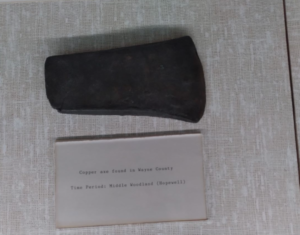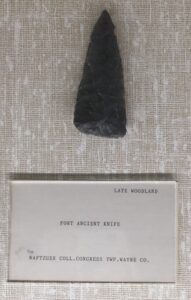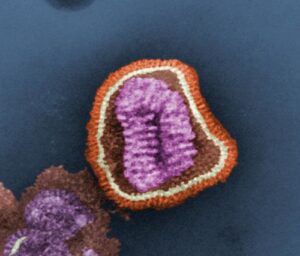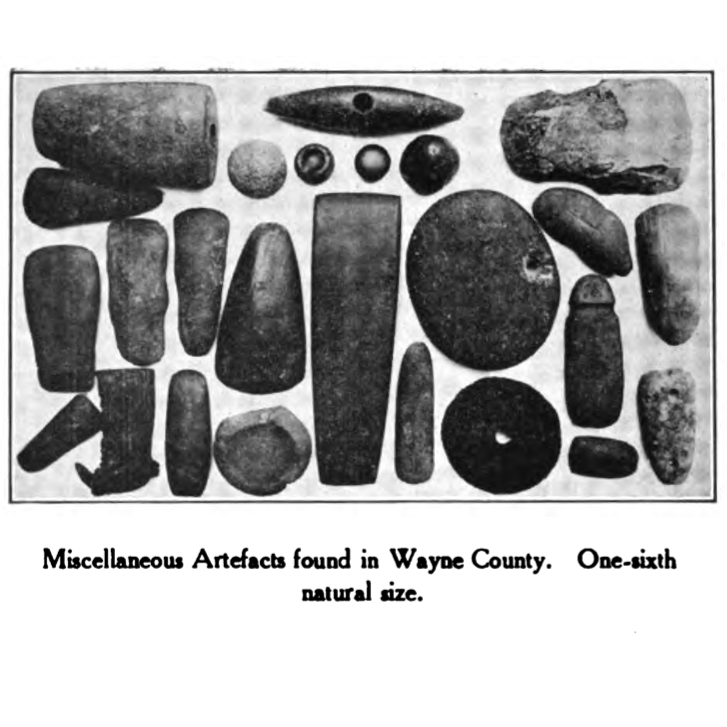Below is a timeline of the different periods of indigenous history in Ohio, from 13,000 BCE to today. This timeline was created by Knightlab, using information from Virtual First Ohioans and Ohio History Central.
Wooster and Wayne County has a rich history of indigenous cultures that dates back 11,000 years. The first Indigenous people here were the Paleo Indians, ancestors of the Lenape people. As time went by, three cultures arose and became prevalent among the cultures that were present: Adena, Hopewell, and Fort Ancient.
Adena culture developed in the Early Woodland period, lasting from 1000 BCE to 1 CE.1 Kevin F Kern and Gregory S. Wilson, 2013. Ohio : A History of the Buckeye State. Somerset: John Wiley & Sons, Incorporated. Accessed May 21, 2021. ProQuest Ebook Central. The Adena’s successors were the Hopewell culture, who appeared in the Middle Woodland period and were present from 500 BC- 1100 CE. 2 ibid. Finally, the period of Fort Ancient culture started in 1100 CE and lasted only for 500 years, before the arrival of Europeans. 3Robert A Cook, CONTINUITY AND CHANGE IN THE NATIVE AMERICAN VILLAGE: Multicultural Origins and Descendants… of the Fort Ancient Culture. S.l.: CAMBRIDGE UNIV PRESS, 2021 These three cultures left their marks in Wooster and Wayne County with many artifacts and archaeological sites; some are being protected and preserved, while others have been lost.
Early Cultures of Northeast Ohio
Although mounds and enclosures in Wooster and Wayne County have not been fully excavated, archaeologists have found a wealth of information about the three cultures through other sites in Ohio. For example, the Adena replaced the other civilizations in the Archaic period and lasted through the Woodland period. Adena people led a sedentary lifestyle, relying mostly on hunting, nuts, and plants.4 Kevin F Kern and Gregory S. Wilson, 2013. Ohio : A History of the Buckeye State. Somerset: John Wiley & Sons, Incorporated. Accessed May 21, 2021. ProQuest Ebook Central, 31.
They used pottery to store food, and later developed more decorative potteries.5 ibid, 31-32. The Adena people also built mounds for ceremonial purposes.6 ibid, 32 When their successors, the Hopewell culture, arose in the Middle Woodland period, they had similar cultural practices as the Adena people. They also built mounds for various purposes, such as the Fort Hill burial mound in Wayne County.7 Fred Michel. “History, Condition and Proposal for Preservation of an Important Archaeological Site,” 2016, 2. The Hopewell culture was an advanced civilization compared to the Adena and was interconnected to several tribes throughout North America.8 “Hopewell Culture.” Hopewell Culture – Ohio History Central. Ohio History Connection. Accessed May 27, 2021. Lastly, the Fort Ancient culture was more disconnected from previous cultures, given their traditions and practices.
When their successors, the Hopewell culture, arose in the Middle Woodland period, they had similar cultural practices as the Adena people. They also built mounds for various purposes, such as the Fort Hill burial mound in Wayne County.9Michel, 2 The Hopewell culture was an advanced civilization compared to the Adena and was interconnected to several tribes throughout North America.10“Hopewell Culture” Lastly, the Fort Ancient culture was more disconnected from previous cultures, given their traditions and practices.
They were not traditional mound builders like the other cultures; they only built mounds when needed.11 “Late Prehistoric Period – The Fort Ancient Culture · The Moundbuilders’ Art: A Confluence of “Ingenuity, Industry, and Elegance”. Open Virtual Worlds.They led even more of a sedentary lifestyle than the Adena people, relying less on hunting and more on crops like maize (corn), squash, and beans.12Knepper, 22-23 Even though we have significant knowledge about these cultures, archaeologists are still researching to find out more, and that can only be done if we preserve and excavate the sites.
Disappearance of Ancient Cultures
Archaeologists, modern Native American tribes, and settlers alike have pondered the disappearance of these cultures for centuries. Even though the Fort Ancient assumably was present until the 1650s, there is no known record of their contact with the Europeans.13“Late Historic Period- the Fort Ancient Culture”, n.d Some speculate that these tribes evolved and morphed into other tribes. For example, the Adena may have evolved into a more advanced civilization like the Hopewell.14Kern & Wilson, 34 Other historians suggest that these tribes faced a grave disaster.
The climate change theory suggests that an ice age in the 1200s may have wiped out crop supplies or caused disease as it did in Europe.15“Mound Builders” Cultures like Fort Ancient could have gone extinct because of diseases carried by early European explorers, but this is just speculation since we have no records of them having contact with the Europeans.16“Mound Builders: Why Did they Disappear from Ohio?”, n.d
Another theory is that a blight or disease could have killed the crops used by these cultures as they appeared to rely heavily on agriculture. The Fort Ancient culture was especially dependent on the success of their harvest to survive.
Finally, one theory suggests that the ancient societies may have been killed off by a war, although historians do not know if they had any rivalry with other cultures.17“Mound Builders”, n.d We may have concrete evidence for these theories or may even develop a new one as archaeologists conduct more research about these cultures.
Archeological sites in Wayne County and Wooster
Wayne County is home to several enclosures and mounds that once belonged to a powerful and influential ancient culture. The Wooster area is currently home to 5 mounds, 3 earthen enclosures, 4 village sites, and 1 burial site.18Michel, 1
Similar mounds can be found all over Ohio, such as at Chillicothe and Newark in Medina County. Local enthusiasts say that there were previously many more, but these have since been either plowed, built on, or paved over. One of the most striking surviving sites is the Fort Hill enclosure, a 150-foot-wide triangular valley that is surrounded by high walls with one raised, platform-like corner.19Michel, 2-3 Archeologists uncovered human remains and material artifacts in the early 1900s, suggesting that it was once used as a burial site.
Other archeological sites in the area include the Oakhill Cemetery in Millersburg (about a half hour away from Wooster), and three Archaic mounds at the Pee Wee Hollow Scout Camp.20Michel, 5 These were dug by a team lead by Professor of Archeology at the College of Wooster, Dr. Kardulias, and Professor of Geology, Dr. Wiles. They discovered that the three mounds were built in the late Archaic and early Woodland periods and served as ceremonial or tool making sites.21 John Finn, “Interdisciplinary Collaboration Sheds New Light on the Mounds of Pee Wee Hollow.” The College of Wooster, February 28, 2014.Local enthusiasts also surmise that the Wooster cemetery is a possible archeological site, and that when Europeans came through the area, they continued to use the land for burial.22 Interview with Dr. Michel on Local Archeology, June 2, 2021
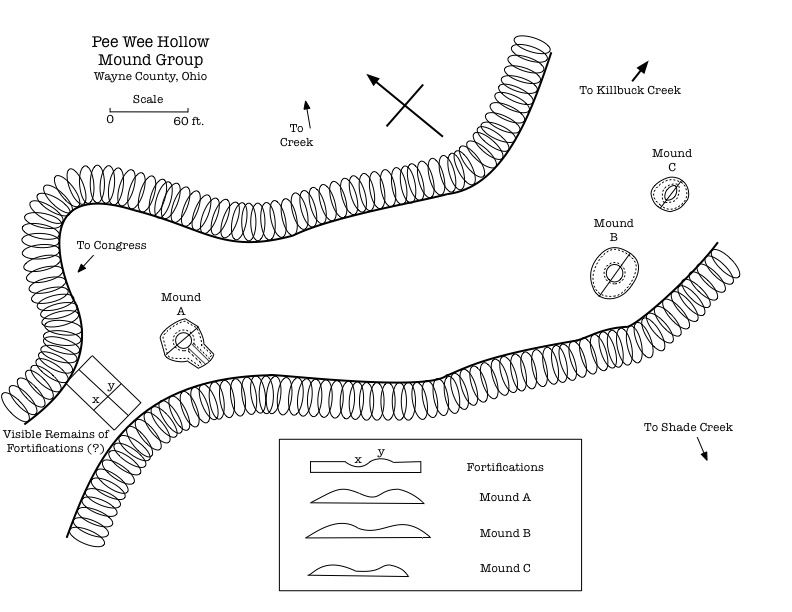
Secrets of the Pee Wee Hollow Mound
Learn about one of Wooster’s ancient archeological sites, hidden away in a local Boy Scout camp.
Archeological Sites Today
As of 2021, local enthusiasts and experts are hoping to convert ancient Hopewell sites into places of education and cultural preservation. Local advocates like Ohio State University’s Dr. Fred Michel would like to see the Fort Hill site develop into a local educational park, as many residents have not been taught about Wooster’s ancient history.23Michel, 8 So far, little work has been done to preserve sites in Wayne County, because records of these sites are sparse. Historically, information about archeological sites’ location has been kept secret as to prevent them from being looted.24Interview with Dr. Michel on Local Archeology, June 2, 2021In the future, Dr. Michel hopes to involve local historical organizations such as the Wayne County Historical Society, the Ohio History Connection, and the College of Wooster as well as any interested indigenous organizations to preserve this rare enclosure and open it to the public.
The Ohio History Connection (OHC) is similarly trying to gain access to other archeological sites, such as the Newark Earthworks. The Ohio State Supreme Court will be hearing an appeal from its current owners, the Moundbuilders Country Club, but the pandemic has delayed this process. The OHC also hopes to have these sites designated as UNESCO World Heritage sites, and Dr. Michel similarly hopes that the Fort Hill site will receive this recognition.25Michel, 8
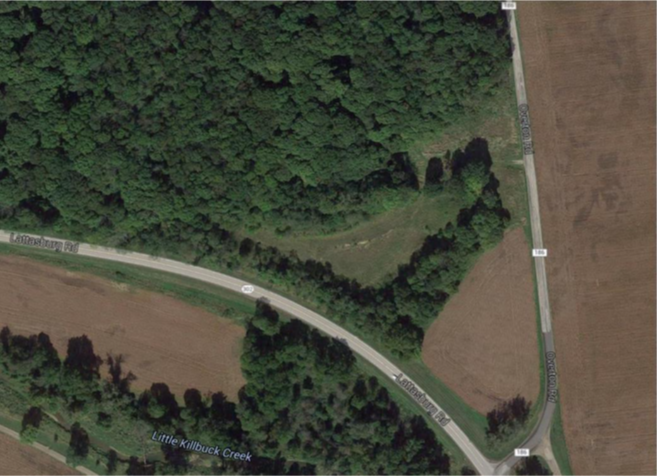
Preservation of the Fort Hill Site
Learn about one Ohio State University professor’s efforts to preserve Wooster’s ancient history.
For Further Reading: EDIT TO BE JUST KEY WORKS
1) Kern, Kevin F., and Wilson, Gregory S.. 2013. Ohio : A History of the Buckeye State. Somerset: John Wiley & Sons, Incorporated. Accessed May 21, 2021. ProQuest Ebook Central.
2) Cook, Robert A. CONTINUITY AND CHANGE IN THE NATIVE AMERICAN VILLAGE: Multicultural Origins and Descendants… of the Fort Ancient Culture. S.l.: CAMBRIDGE UNIV PRESS, 2021.
3) Michael, Fred. “History, Condition and Proposal for Preservation of an Important Archaeological Site,” 2016.
4) “Hopewell Culture.” Hopewell Culture – Ohio History Central. Ohio History Connection. Accessed May 27, 2021. https://ohiohistorycentral.org/w/Hopewell_Culture.
5) “Late Prehistoric Period – The Fort Ancient Culture · The Moundbuilders’ Art: A Confluence of “Ingenuity, Industry, and Elegance” · Open Virtual Worlds.
6) Knepper, George. Ohio and Its People. 3rd ed. Kent, Ohio: Kent State University Press, 2003 https://ebookcentral.proquest.com/lib/wooster/reader.action?docID=4403606.
7) “Mound Builders: Why Did They Disappear from Ohio?” http://touringohio.com/history/mound-builders-disappear.html.Accessed 4 June 2021.
8) Finn, John. “Interdisciplinary Collaboration Sheds New Light on the Mounds of Pee Wee Hollow.” The College of Wooter, February 28, 2014. https://www.wooster.edu/offices/marketing/news-archive/2014/february/peeweehollow-mounds/index.php.
9) Kardulias, Nick, David Taggart, Brittany Rancour, Nigel Brush, Roger Rowe, and Gregory Wiles. “A Small Prehistoric Mound Group (33-WE-3) In Wayne County, Northeast Ohio.” Pennsylvania Archeologist 84 (2014): 62–75.
10) Mills, William C. Archeological Atlas of Ohio, 1914.
11) Virtual First Ohioans. https://lostworlds.org/virtual-ohioans. Accessed 23 May 2021.

